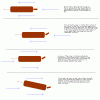HunterSeeker
Newbie
- Joined
- Apr 13, 2004
- Messages
- 1,694
- Reaction score
- 0
Lets imagine you are on a ship proppeled by a propeller. Suddenly the engine dies and the propeller stops. The ship is head towards a reef, now would turning the rodder allow you to avoid the reef or would it just change which part of the ship takes the initial inpact?


